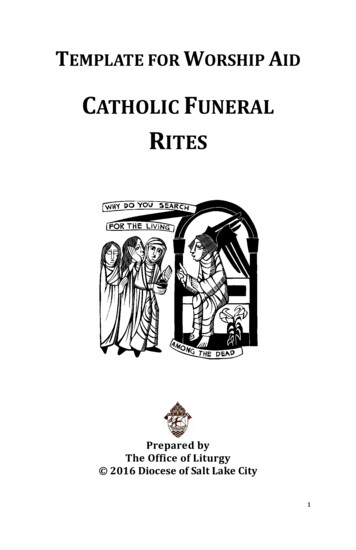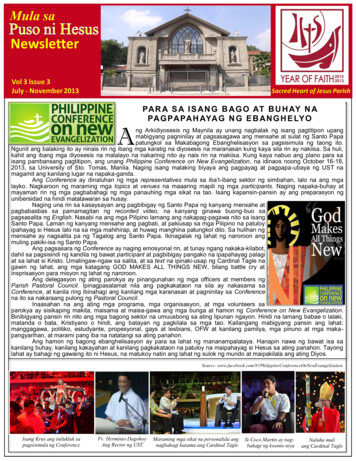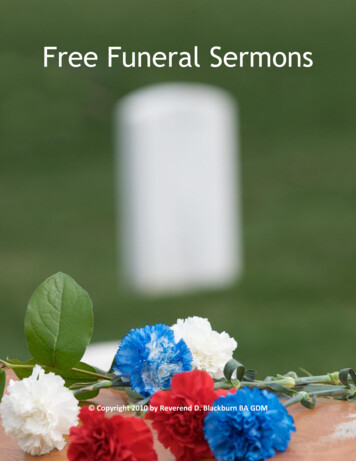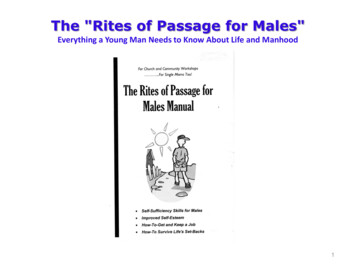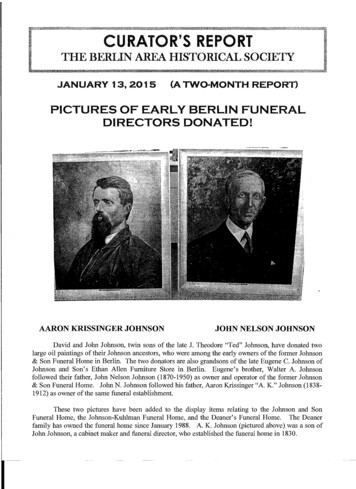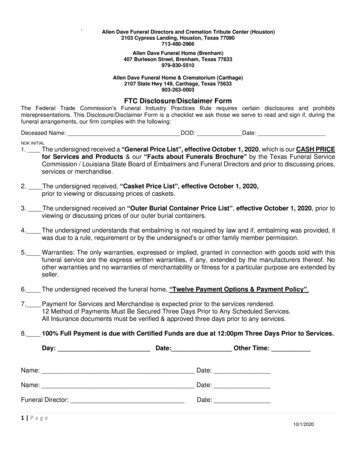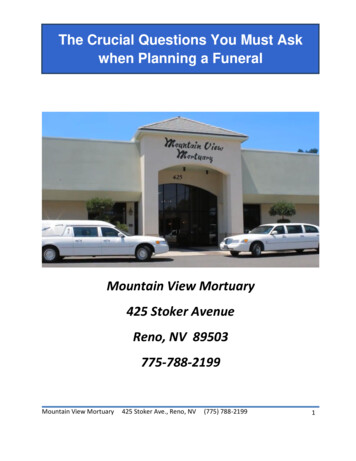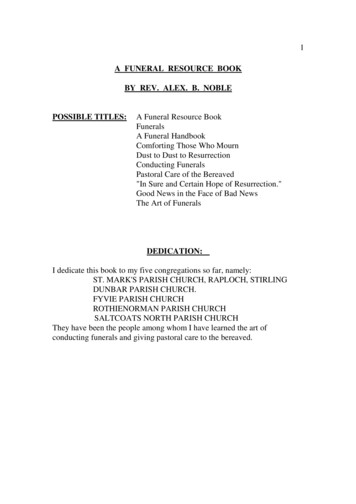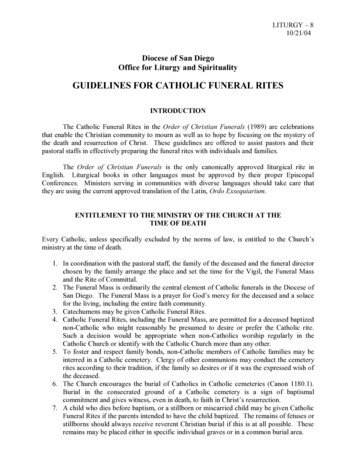
Transcription
LITURGY – 810/21/04Diocese of San DiegoOffice for Liturgy and SpiritualityGUIDELINES FOR CATHOLIC FUNERAL RITESINTRODUCTIONThe Catholic Funeral Rites in the Order of Christian Funerals (1989) are celebrationsthat enable the Christian community to mourn as well as to hope by focusing on the mystery ofthe death and resurrection of Christ. These guidelines are offered to assist pastors and theirpastoral staffs in effectively preparing the funeral rites with individuals and families.The Order of Christian Funerals is the only canonically approved liturgical rite inEnglish. Liturgical books in other languages must be approved by their proper EpiscopalConferences. Ministers serving in communities with diverse languages should take care thatthey are using the current approved translation of the Latin, Ordo Exsequiarium.ENTITLEMENT TO THE MINISTRY OF THE CHURCH AT THETIME OF DEATHEvery Catholic, unless specifically excluded by the norms of law, is entitled to the Church’sministry at the time of death.1. In coordination with the pastoral staff, the family of the deceased and the funeral directorchosen by the family arrange the place and set the time for the Vigil, the Funeral Massand the Rite of Committal.2. The Funeral Mass is ordinarily the central element of Catholic funerals in the Diocese ofSan Diego. The Funeral Mass is a prayer for God’s mercy for the deceased and a solacefor the living, including the entire faith community.3. Catechumens may be given Catholic Funeral Rites.4. Catholic Funeral Rites, including the Funeral Mass, are permitted for a deceased baptizednon-Catholic who might reasonably be presumed to desire or prefer the Catholic rite.Such a decision would be appropriate when non-Catholics worship regularly in theCatholic Church or identify with the Catholic Church more than any other.5. To foster and respect family bonds, non-Catholic members of Catholic families may beinterred in a Catholic cemetery. Clergy of other communions may conduct the cemeteryrites according to their tradition, if the family so desires or if it was the expressed wish ofthe deceased.6. The Church encourages the burial of Catholics in Catholic cemeteries (Canon 1180.1).Burial in the consecrated ground of a Catholic cemetery is a sign of baptismalcommitment and gives witness, even in death, to faith in Christ’s resurrection.7. A child who dies before baptism, or a stillborn or miscarried child may be given CatholicFuneral Rites if the parents intended to have the child baptized. The remains of fetuses orstillborns should always receive reverent Christian burial if this is at all possible. Theseremains may be placed either in specific individual graves or in a common burial area.
8. The Order for Christian Funerals provides a complete funeral liturgy for children whohave died (OCF #234-342). The various texts for a baptized child or a child who diedbefore baptism make these rites fully adaptable to various situations, and offerconsolation for those suffering the extraordinary grief which comes with the death of achild.9. There is no objection to Catholics making prior arrangements to donate their bodies orparts of them, after certain death, to advance medical science. Upon eventual dispositionof the body or its parts, there should be reasonable assurance that the remains will bedisposed of in a proper, reverential manner. The family of such a donor should beencouraged to celebrate a Mass as soon as possible after death. Whatever remains of thebody after an organ transplant or medical research should be given appropriate burial.The rite of final committal with final commendation (OCF #224-233) offers a model forconcluding prayers for the donor and the donor’s family.INVOLVEMENT OF THE ENTIRE PARISH COMMUNITYSince the ministry of consolation belongs to the entire Christian community, the entirecommunity is to be involved in caring for the dying, praying for the dead and comforting thosewho mourn.1. Regular catechesis is encouraged to help parishioners understand their role in ministeringto those who have suffered the loss of a loved one.2. Parish policies, procedures and ministerial resources are to be developed in light of theseguidelines and communicated clearly to parishioners so they can take full advantage ofthe services available to them at the time of death.3. Funeral directors provide an invaluable service to families and to the Church. Often thefuneral director provides the first response to a family who has experienced the death of aloved one. It is important for parish staffs and local funeral directors to cultivate anattitude of mutual respect and effective collaboration. Annual meetings with funeraldirectors within a parish or cluster of parishes are encouraged. Funeral directors areencouraged to include study of the Order of Christian Funerals as part of their regular inservice study, and are invited to call upon the services of the Office for Liturgy andSpirituality.MINISTRIES IN THE RITES OF THE ORDER FOR CHRISTIAN FUNERALSIn keeping with the norms found in the Order of Christian Funerals, priests and deacons are toshare the responsibility for planning and implementation of the Order with qualified layministers.1. Priests, as teachers of faith and ministers of comfort, preside at the funeral rites,especially the Mass; the celebration of the funeral liturgy is especially entrusted topastors and associate pastors. When no priest is available, deacons, as minister of theword, of the altar, and of charity, preside at funeral rites. When no priest or deacon isavailable for the vigil and related rites or the rite of committal, a layperson presides(OCF, n. 14).2. The rite, Gathering in the Presence of the Body (OCF #109-118), may be used if a priest,deacon, or parish minister is present at the time of death, or when the family first visitsthe body.3. A pastoral visit to the family by the priest celebrating the Funeral Mass is an expectedpart of the Church’s ministry of consolation. The ministry of a bereavement group orministry of consolation is never to substitute for the pastoral visit of the priest.2
4. Part of the priest’s ministry to the grieving family may include the offer to celebrate thesacrament of reconciliation. This may be appropriate when the family has notparticipated in worship for some time. However this does not warrant general absolution.5. The service of all appropriate liturgical ministers is recommended in the celebration ofthe various liturgies of the Order of Christian Funerals. Laymen and laywomen mayserve as readers, musicians, ushers, pallbearers and, according to existing norms, asspecial ministers of the eucharist (OCF #15).6. The preparation of the liturgy can provide consolation for the mourners. However thepreparation of the liturgy should never become a burden for the family. The Order ofChristian Funerals recommends that family members be involved in some of theliturgical roles, unless they prefer not to be involved (OCF #15). Nevertheless, theymight designate the persons to place the pall or appropriate symbols on the casket at thereception of the body at the doors of the church, as well as the persons to bring gifts ofbread and wine to the altar (OCF #152).7. Music selected for the Order of Christian Funerals should be appropriate for Christianprayer and conform to liturgical directives. The texts of the music should express thepaschal mystery of Christ’s passion, death, and resurrection. This is especially importantfor the Song of Farewell. Popular non-religious songs are not to be used in the liturgy.THE VIGILThe vigil is often the first time family, friends and members of the parish community gather inremembrance of the deceased, for prayer and support. The vigil may be celebrated in the homeof the deceased, in the funeral home, or in the church.1. During the wake, the Vigil for the Deceased is the principal rite celebrated by the Churchin the time following death and before the Funeral Liturgy. The practice of scheduling aspecific hour for the Vigil for the Deceased is encouraged in order for more of the faithfulto participate in this liturgy. Devotions such as the rosary are permitted at other timesduring the wake.2. The Vigil for the Deceased may provide a chance to take part in the funeral rites for thoseunable to participate in the Funeral Mass or Rite of Committal.3. When no priest or deacon is available, it is permissible for a trained lay minister to bedesignated by the pastor to preside at the Vigil for the Deceased, providing the person hasbeen formed in an understanding of the Order of Christian Funerals and is also skilled atleading public prayer.4. After the Prayer of Intercession or at some other suitable time during the Vigil, it isappropriate for a family member or a friend to speak in remembrance of the deceased(OCF #62).5. When the Vigil for the Deceased is celebrated in a church, a priest or deacon is to bevested in an alb and stole. A lay minister who presides wears lay clothing in accord withthe dignity of the role or is vested in an alb (cf. Guidelines for Lay Presiders).6. When a wake takes place in the church the Vigil for the Deceased with Reception at theChurch (OCF #82) is to be celebrated.7. Particular groups may be invited to celebrate a prayer service for the deceased in additionto the Vigil for the Deceased or there may be distinct times of prayer within the wake.The Liturgy of the Hours, Office for the Dead, (OCF, Part IV) provides a form of a Vigilfor the Deceased. Morning prayer from the Office might also be celebrated on the day ofcommittal, following an evening Funeral Mass.3
8. The presence of a cantor or other music minister at the Vigil for the Deceased can behelpful in leading the people in prayer, particularly in the singing of the psalms andresponses of the liturgy.SCHEDULING THE FUNERAL LITURGIES1. The Funeral Mass may be celebrated at any hour of the day. Each parish should developa clear policy on funeral schedules that is shared with parishioners and local funeraldirectors. While local policy should take into account the daily Mass of the parish, theavailability of priests, the scheduling of liturgies and other parish events, sensitivity to thegrieving family should be paramount in scheduling the Funeral Mass.2. If the Funeral Mass is celebrated in the evening, a sufficient length of time shouldseparate it from the celebration of the Vigil for the Deceased. The schedule for the Riteof Committal, ordinarily the next day, should be announced and the faithful invited toreconvene at that time.3. The Vigil for the Deceased should be celebrated at a convenient time. The time may bepublished in the newspaper obituary notice.4. Funeral directors are asked to respect the correct names of the various liturgical rites inwritten obituary notices. Proper terms such as “Vigil for the Deceased”, “Funeral Mass”,“Funeral Liturgy outside Mass”, and “Rite of Committal” are encouraged.5. Morning Prayer and Evening Prayer from the Office for the Dead (OCF, Part IV) may bescheduled during the time of the wake. The Office for the Dead may be celebrated in thefuneral home, church, or oratory of a religious community, or in the family home.6. Funeral Masses are not celebrated on solemnities of obligation, on Holy Thursday, GoodFriday, Holy Saturday, Easter Sunday, or on the Sundays of Advent, Lent and the EasterSeason. At a Funeral Mass celebrated on Ash Wednesday, ashes are not distributed.7. On days when the Funeral Mass may not be celebrated, the appropriate Rite is theFuneral Liturgy outside of Mass.8. Although the Funeral Mass is ordinarily celebrated in the parish church to which thedeceased belonged, it is possible to choose any Catholic church for the Funeral Mass,provided the pastor of that church agrees and the pastor of the deceased has beeninformed (Canon 1177). The Funeral Mass may also be celebrated in chapels of Catholiclong-term care institutions.9. If two or more families, or a religious community, desire it, a Funeral Mass may becelebrated for more than one person.10. The Funeral Mass may be celebrated at one of the regularly scheduled daily Masses inthe parish. Particularly in instances where the deceased does not have a large family orcircle of friends, the presence of the daily Mass community is extremely consoling to themourners. A core group of readers, eucharistic ministers, funeral choir, and servers mayemerge from the daily Mass community.PREACHING AND EULOGIES1. Only a priest or deacon may preach the homily at the funeral liturgy.2. A eulogy is not appropriate where a homily is prescribed (OCF #27), although examplesfrom the person’s life may be used in the homily. The literary genre of eulogy is not ahomiletic form. Rather, the homily is to “illumine the mystery of Christian death in thelight of the risen Christ.” (Catechism of the Catholic Church #1688) as proclaimed in thereadings.3. Excellence in preaching is of critical importance to the evangelizing task of the Church,4
especially at a moment when the faithful who live apart from the regular life of theChurch may yearn for a message of faith and Christian hope.4. In the Diocese of San Diego, one speaker chosen by the family may offer a five-minuteremembrance of the deceased at the Funeral Liturgy before the final commendation,especially if there was no vigil or wake service. The remarks are to be simple, brief, andprepared. Care must be taken to follow this. Some priests have found it helpful to seethe text beforehand. Within the context of a liturgy, the tone should remain one of faithand hope.5. The Vigil for the Deceased is a more fitting time for individuals to share remembrancesof the deceased.THE FUNERAL MASSIn the dioceses of the United States, the principal rituals in the Order of Christian Funerals arethe Vigil for the Deceased, the Funeral Mass, and the Rite of Committal. The Funeral Mass isthe central liturgy of the Christian funeral in the Diocese of San Diego.1. The Eucharist is the heart of the Paschal reality of Christian death (Catechism of theCatholic Church #1689). In the celebration of the Eucharist, the Church most perfectlyexpresses her communion with those who have died. The celebration of the Eucharist atthe funeral is an opportunity for the community of the faithful, and for the family, to“learn to live in communion with the one who has ‘fallen asleep in the Lord,’ bycommunicating the Body of Christ of which he is a living member and, then, by prayingfor him and with him” (Catechism of the Catholic Church #1689)2. The Introductory Rites of the Funeral Mass presume a greeting of the mourners whoaccompany the body to the doors of the church. They are greeted by the priest andliturgical ministers, and other persons who have gathered at the church to await theprocession from the funeral home or family home. The ritual plan for a parish must takeinto account the structure of the liturgy, the size of the assembly and the architecture ofthe church.3. It is not ordinarily permitted to seat the family members who accompany the body beforethe body is presented for blessing. Parishes are called upon to develop, in collaborationwith funeral directors, policies which result in seating on both sides of the church andtowards the front of the assembly area.THE FUNERAL LITURGYOUTSIDE MASSIt is the custom in the United States for a priest or deacon to preside at the funeral liturgy when itis celebrated outside of Mass.1. The Funeral Liturgy outside Mass (OCF #177-203) is celebrated when a Mass is notpossible or not deemed appropriate. It is ordinarily celebrated in the parish church, but itmay also be celebrated in the funeral home, the home of the deceased or cemetery chapel(OCF #179). The pastoral advice of the parish priest is essential in determining what isappropriate.2. The family may choose to celebrate a funeral outside of Mass, and schedule a memorialMass at a later date, when it is determined in consultation with the parish priest that thisform of the funeral liturgy is a more suitable form of celebration.5
3. When the funeral liturgy is celebrated outside Mass, the community nonetheless gathersto hear the message of Easter hope proclaimed in the liturgy of the word and to commendthe deceased to God.4. The readings are chosen from those approved for Masses for the Dead.5. Although the Order of Christian Funerals includes the possibility of Holy Communion inthis form of the liturgy, this practice is discouraged in the Diocese of San Diego.6. Music is an essential element of this form of celebration, which includes the entrance orgathering song, the responsorial psalm, the gospel acclamation, and especially the song offarewell at the final commendation.MUSIC IN THE FUNERAL LITURGYIt is the pastoral responsibility of parishes to provide liturgical music at all Funeral Masses. Thesame liturgical norms applied to music at any Mass apply to the Funeral Mass.1. An instrumentalist, a cantor, and even a choir where possible should assist the fullparticipation of the assembly in the songs, responses, and acclamations of the funeralRites (OCF #33).2. Certain musical texts are primary and should be sung at the Funeral Mass: theresponsorial psalm, the gospel acclamation, the three acclamations of the EucharisticPrayer, the “Lamb of God” litany, and the “Song of Farewell.” These should not be sungby cantor, choir, or soloist alone. Rather, they belong to the assembly.3. In the Order of Christian Funerals, as in all the reformed liturgical books, thecantor/leader of song has an important task. The task of the cantor is to animate anddirect the singing of the assembly. With the exception of the responsorial psalm, whichis sung from the ambo, the cantor ordinarily leads the assembly from a cantor stand.4. Some form of hymnal or worship program is called for at funerals. The program might bea computer-generated document with the words and music for the liturgy. Copyrightlicenses and permissions are necessary, and many parishes have found annual licenses to beboth convenient and inexpensive. Some liturgical publishers have offered participationcards and booklets for the liturgy that have proven very useful. A separate sheet might beprepared for the participation of the faithful in the committal at the cemetery.5. A choir has proven of great worth in many parishes. Members of a funeral choir areoften recruited from parishioners who are retired, self-employed, or whose work givesthem freedom of schedule.6. The selection of music for the funeral liturgy is often a sensitive issue for bereavedfamilies, parish musicians, and pastoral staff. The choice of music for Christian funeralsmust be in accord with all the recommendations governing music in liturgy, especiallythose found in the Order for Christian Funerals, Liturgical Music Today and Music inCatholic Worship.7. The principle of progressive solemnity, described in Music in Catholic Worship, appliesto the rites found in the Order of Christian Funerals. A few things sung well, (cf. #2above) have priority in funeral liturgies (Liturgical Music Today, #33). Many of thesemay be drawn from the repertoire of the Sunday assembly.8. The responsorial form of psalm singing, in which the psalmist or choir sings the versesand the assembly responds with a brief antiphon, is well suited to the funeral liturgy. Thepractice of substituting metrical hymns based on psalm texts for the responsorial psalm isnot encouraged since this form affects and alters the ritual pattern of responsorial singing(Liturgical Music Today, #40).9. The request for “favorite songs” of the deceased often result in inappropriateperformances of music incapable of bearing the weight liturgy demands. Popular songs,6
sentimental ethnic music, or songs from Broadway hits are never to substitute for themusic of the funeral liturgy. There are three standards of judgment proposed in Music inCatholic Worship. The liturgical judgment: is the music’s text, form, placement and stylecongruent with the nature of the liturgy? (MCW 30-38) The musical judgment: is themusic technically, aesthetically and expressively good irrespective of musical idiom orstyle? (MCW 26-29) The pastoral judgment: will it help this assembly to pray? (MCW39-41) Such a process may not be as easy to apply as an absolute list of permitted orprohibited music, but is more effective pastorally.10. Music is preeminent among the signs expressed by the participants in any liturgy.Therefore, recorded music is not to be used within the liturgy to replace the congregation,the choir, the organist, cantor, or other musicians. (Liturgical Music Today, #60).THE RITE OF COMMITTALThe Rite of Committal is celebrated at the place of burial or interment and never in the church.1. The Rite of Committal, whether at an interment chapel, at a mausoleum or at a graveside,is a gathering of the faithful for prayer.2. Military services and certain cultural or social rites are permissible at the cemetery.These other services should be arranged in advance with the local parish priest andcoordinated in such a way that they do not disrupt or distract from the integrity of theliturgical committal service. Funeral directors are called upon to assist in thecoordination of these elements, and to safeguard the integrity of the Church’s liturgy atthe Rite of Committal.3. If a lengthy time has passed since the celebration of the Funeral Liturgy, or if the funeralhas been conducted overseas or in a distant state, the Rite of Committal with FinalCommenda-tion (OCF #224-233) may be more appropriate.CREMATIONWhile the Church recommends that the pious custom of burying the bodies of the dead beobserved, cremation is permitted as long as it has not been chosen for reasons contrary toCatholic teaching (Canon 1176.3, Catechism of the Catholic Church, #2301).1. It is preferred that the Funeral Mass or the Funeral Liturgy outside Mass be celebrated inthe presence of the body of the deceased prior to its cremation. (OCF AppendixCremation, #411-438.2. The significance of having the body of the deceased present for the funeral liturgy isindicated throughout the Mass texts and ritual actions. Therefore, when arrange-mentsinvolving cremation are being made, the parish priest is to recommend that: a) followinga wake, or a time of visitation, the Funeral Liturgy be celebrated in the presence of thebody of the deceased person, and that following the Funeral Liturgy, the body of thedeceased be cremated; b) the Funeral Mass conclude with the final commendation in thechurch; c) at an appropriate time, usually some days later, the family gather at thecemetery for the burial of the cremated remains. The Rite of Committal takes place atthis time with the inclusion of the proper prayers for the committal of ashes (OCF#406.3).3. If cremation has already taken place before the Funeral Liturgy, the Pastor may permitthe celebration of the Funeral Liturgy in the presence of the cremated remains of thedeceased person. The cremated remains of the body are to be placed in a worthy vessel.Parishes may wish to invest in a parish ossuary (a receptacle in which the funeral urn or7
box is placed). A small table or stand is to be prepared for the cremated remains at theplace normally occupied by the coffin. The funeral urn or ossuary may be carried to itsplace in the entrance procession or placed on this table sometime before the liturgybegins.4. Special circumstances occur, such as health concerns or out-of-state or overseastransport, which prompt families to arrange for cremation before making funeralarrangements. If cremation has taken place, the parish priest is to recommend: a)gathering with family and friends for prayer and remembrance of the deceased; b)celebration of a Funeral Liturgy; c) gathering with family and friends for the interment ofcremated remains at the cemetery in the Rite of Committal.5. Cremated remains should be treated with the same respect given to the remains of ahuman body, and should be entombed or buried, whether in the ground or at sea. Thescattering of cremated remains on the ground or on the sea or keeping any portion ofthem for personal reasons is not the reverent final disposition that the Church directs. Itshould be noted that burial at sea of cremated remains differs from scattering. Anappropriate and worthy container, heavy enough to be sent to its final resting place, maybe dropped into the sea.CUSTOMARY OFFERINGS1. Customary offerings may be accepted by the parish on the occasion of a funeral. Theofferings that are given are to be placed in the parish account (cf. Diocesan PolicyHandbook).2. The offering on the occasion of a funeral does not include the professional fees for anorganist, cantor, or other support services, unless this is part of the employmentagreement for the professional musicians. Fees for musicians should be established onthe parish level by the pastor in consultation with the musicians involved. Each parish isto have a plan for assisting families with financial hardship. Priests and deacons whoseresponsibilities include the spiritual care of patients or residents at various institutionsand hospitals may want to initiate action for charity burials when the deceased has norelatives to do this. Funeral directors should be informed that no offering is expectedfrom the poor or those unable to afford an offering.MINISTRY OF CONSOLATIONThe establishment of a bereavement ministry is encouraged for every parish of the diocese.1. A bereavement ministry is a part of the ministry of the Church. “Those who are baptizedinto Christ and nourished at the same table of the Lord are to be responsible for eachother” (OCF #8). This ministry of mutual charity, caring for others in sickness, death,and mourning, is a call to every believer - priest, deacon, religious, layperson. Theresponsibility of the bereavement ministry rests with the community, which is to beinstructed in this care by pastors, associate pastors, and other ministers.2. The ministry of bereavement extends beyond the time of the funeral to include the daysand weeks after Christian burial.2/018
Catholic Church or identify with the Catholic Church more than any other. 5. To foster and respect family bonds, non-Catholic members of Catholic families may be interred in a Catholic cemetery. Clergy of other communions may conduct the cemetery rites according to their tradition, if the family so desires or if it was the expressed wish of
